Nursing Assignment on Dementia and Anxiety Disorder
VerifiedAdded on 2023/06/10
|13
|3457
|338
AI Summary
This nursing assignment discusses the case study of Mathew Hans, a patient suffering from dementia and anxiety disorder. It covers the pathophysiology of the diagnosis, nursing assessment framework, planning, and implementation of care. The article emphasizes the importance of a multidisciplinary approach and psychosocial interventions like CBT and talk therapy accompanied by antidepressants.
Contribute Materials
Your contribution can guide someone’s learning journey. Share your
documents today.
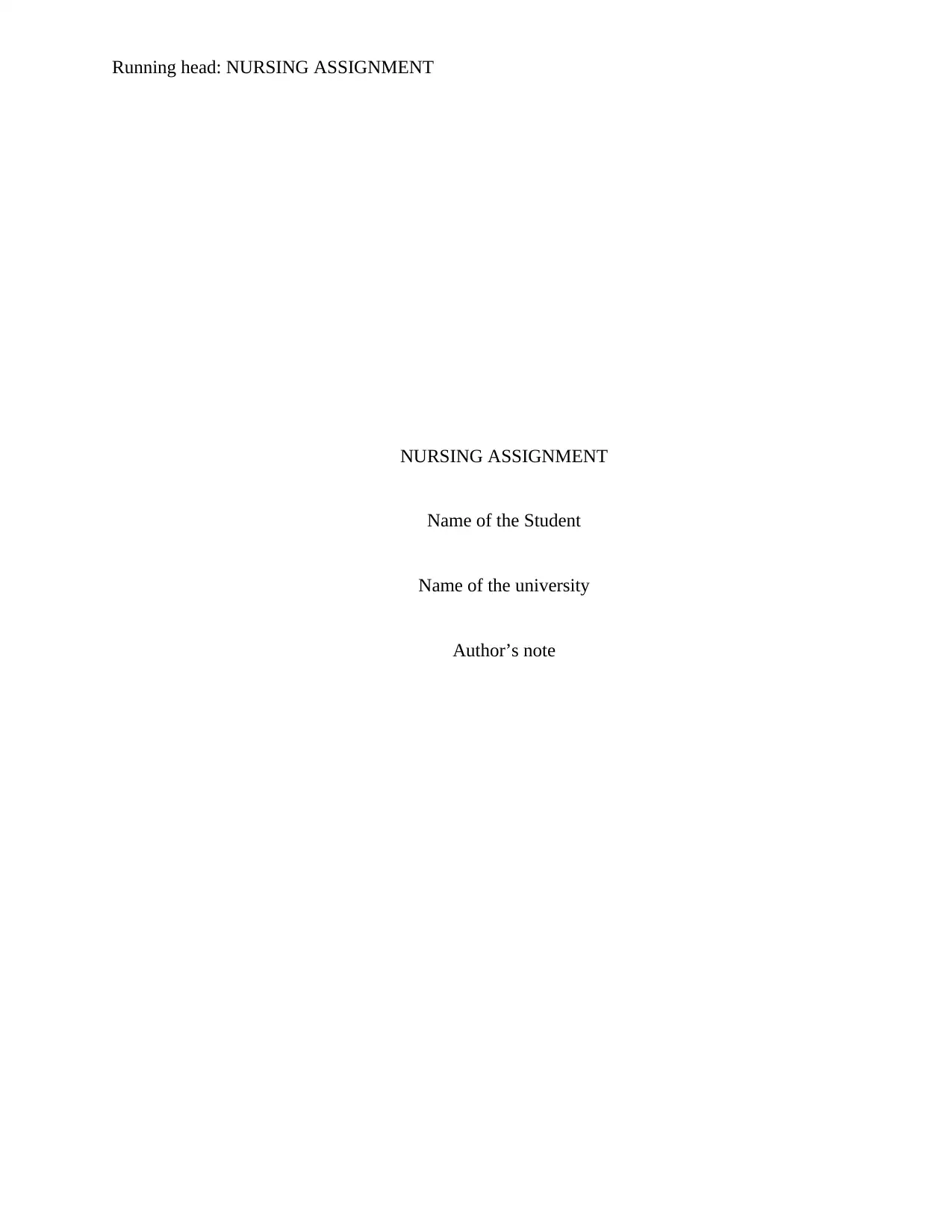
Running head: NURSING ASSIGNMENT
NURSING ASSIGNMENT
Name of the Student
Name of the university
Author’s note
NURSING ASSIGNMENT
Name of the Student
Name of the university
Author’s note
Secure Best Marks with AI Grader
Need help grading? Try our AI Grader for instant feedback on your assignments.
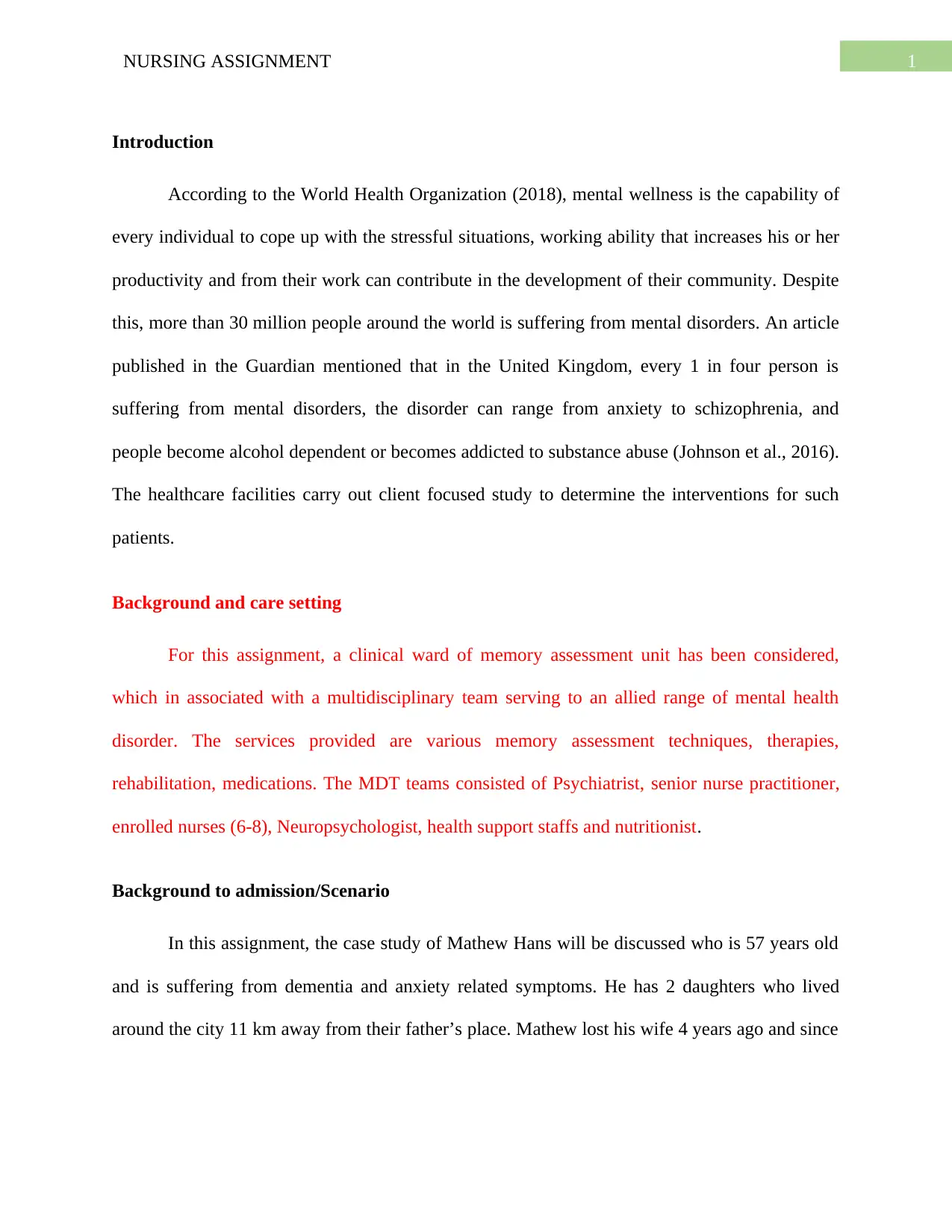
1NURSING ASSIGNMENT
Introduction
According to the World Health Organization (2018), mental wellness is the capability of
every individual to cope up with the stressful situations, working ability that increases his or her
productivity and from their work can contribute in the development of their community. Despite
this, more than 30 million people around the world is suffering from mental disorders. An article
published in the Guardian mentioned that in the United Kingdom, every 1 in four person is
suffering from mental disorders, the disorder can range from anxiety to schizophrenia, and
people become alcohol dependent or becomes addicted to substance abuse (Johnson et al., 2016).
The healthcare facilities carry out client focused study to determine the interventions for such
patients.
Background and care setting
For this assignment, a clinical ward of memory assessment unit has been considered,
which in associated with a multidisciplinary team serving to an allied range of mental health
disorder. The services provided are various memory assessment techniques, therapies,
rehabilitation, medications. The MDT teams consisted of Psychiatrist, senior nurse practitioner,
enrolled nurses (6-8), Neuropsychologist, health support staffs and nutritionist.
Background to admission/Scenario
In this assignment, the case study of Mathew Hans will be discussed who is 57 years old
and is suffering from dementia and anxiety related symptoms. He has 2 daughters who lived
around the city 11 km away from their father’s place. Mathew lost his wife 4 years ago and since
Introduction
According to the World Health Organization (2018), mental wellness is the capability of
every individual to cope up with the stressful situations, working ability that increases his or her
productivity and from their work can contribute in the development of their community. Despite
this, more than 30 million people around the world is suffering from mental disorders. An article
published in the Guardian mentioned that in the United Kingdom, every 1 in four person is
suffering from mental disorders, the disorder can range from anxiety to schizophrenia, and
people become alcohol dependent or becomes addicted to substance abuse (Johnson et al., 2016).
The healthcare facilities carry out client focused study to determine the interventions for such
patients.
Background and care setting
For this assignment, a clinical ward of memory assessment unit has been considered,
which in associated with a multidisciplinary team serving to an allied range of mental health
disorder. The services provided are various memory assessment techniques, therapies,
rehabilitation, medications. The MDT teams consisted of Psychiatrist, senior nurse practitioner,
enrolled nurses (6-8), Neuropsychologist, health support staffs and nutritionist.
Background to admission/Scenario
In this assignment, the case study of Mathew Hans will be discussed who is 57 years old
and is suffering from dementia and anxiety related symptoms. He has 2 daughters who lived
around the city 11 km away from their father’s place. Mathew lost his wife 4 years ago and since
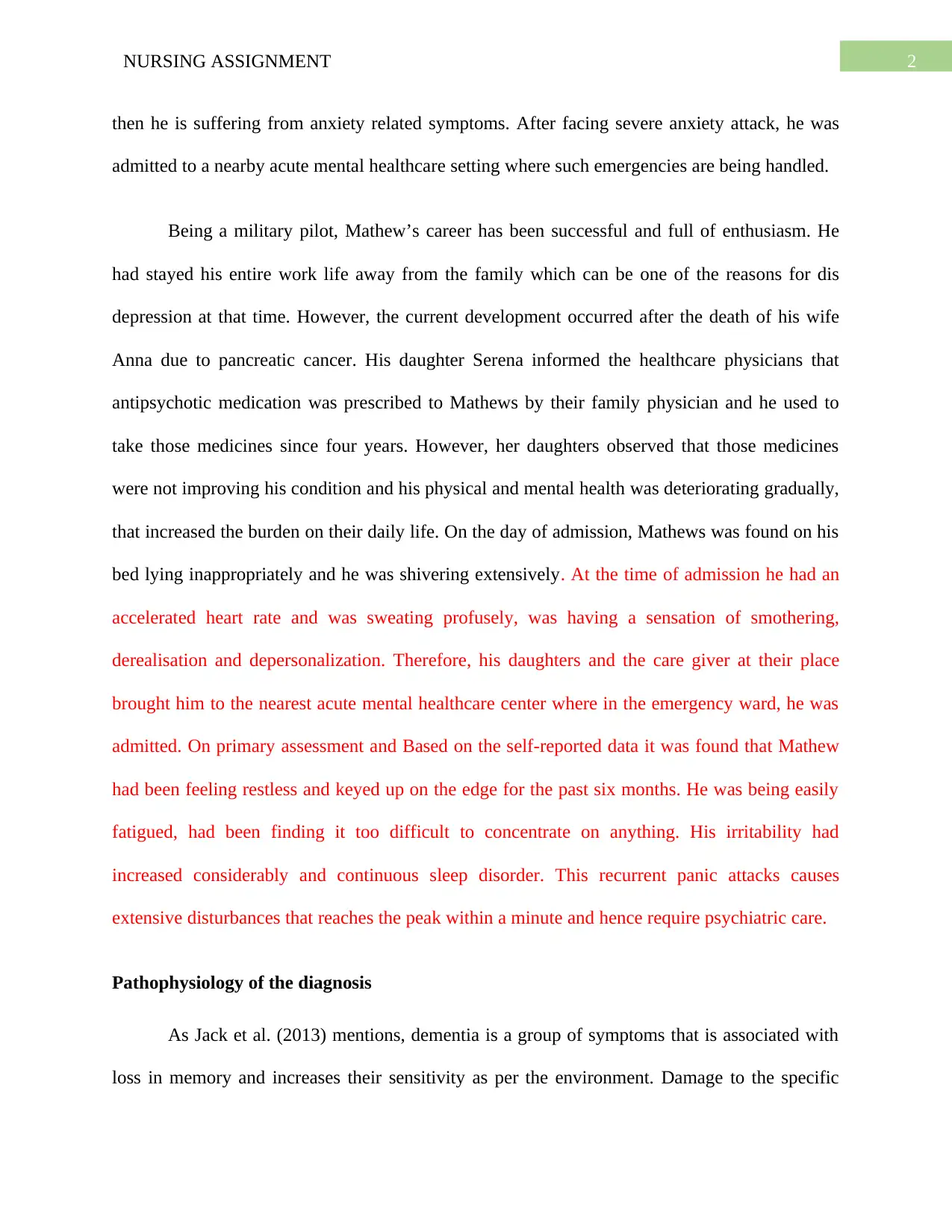
2NURSING ASSIGNMENT
then he is suffering from anxiety related symptoms. After facing severe anxiety attack, he was
admitted to a nearby acute mental healthcare setting where such emergencies are being handled.
Being a military pilot, Mathew’s career has been successful and full of enthusiasm. He
had stayed his entire work life away from the family which can be one of the reasons for dis
depression at that time. However, the current development occurred after the death of his wife
Anna due to pancreatic cancer. His daughter Serena informed the healthcare physicians that
antipsychotic medication was prescribed to Mathews by their family physician and he used to
take those medicines since four years. However, her daughters observed that those medicines
were not improving his condition and his physical and mental health was deteriorating gradually,
that increased the burden on their daily life. On the day of admission, Mathews was found on his
bed lying inappropriately and he was shivering extensively. At the time of admission he had an
accelerated heart rate and was sweating profusely, was having a sensation of smothering,
derealisation and depersonalization. Therefore, his daughters and the care giver at their place
brought him to the nearest acute mental healthcare center where in the emergency ward, he was
admitted. On primary assessment and Based on the self-reported data it was found that Mathew
had been feeling restless and keyed up on the edge for the past six months. He was being easily
fatigued, had been finding it too difficult to concentrate on anything. His irritability had
increased considerably and continuous sleep disorder. This recurrent panic attacks causes
extensive disturbances that reaches the peak within a minute and hence require psychiatric care.
Pathophysiology of the diagnosis
As Jack et al. (2013) mentions, dementia is a group of symptoms that is associated with
loss in memory and increases their sensitivity as per the environment. Damage to the specific
then he is suffering from anxiety related symptoms. After facing severe anxiety attack, he was
admitted to a nearby acute mental healthcare setting where such emergencies are being handled.
Being a military pilot, Mathew’s career has been successful and full of enthusiasm. He
had stayed his entire work life away from the family which can be one of the reasons for dis
depression at that time. However, the current development occurred after the death of his wife
Anna due to pancreatic cancer. His daughter Serena informed the healthcare physicians that
antipsychotic medication was prescribed to Mathews by their family physician and he used to
take those medicines since four years. However, her daughters observed that those medicines
were not improving his condition and his physical and mental health was deteriorating gradually,
that increased the burden on their daily life. On the day of admission, Mathews was found on his
bed lying inappropriately and he was shivering extensively. At the time of admission he had an
accelerated heart rate and was sweating profusely, was having a sensation of smothering,
derealisation and depersonalization. Therefore, his daughters and the care giver at their place
brought him to the nearest acute mental healthcare center where in the emergency ward, he was
admitted. On primary assessment and Based on the self-reported data it was found that Mathew
had been feeling restless and keyed up on the edge for the past six months. He was being easily
fatigued, had been finding it too difficult to concentrate on anything. His irritability had
increased considerably and continuous sleep disorder. This recurrent panic attacks causes
extensive disturbances that reaches the peak within a minute and hence require psychiatric care.
Pathophysiology of the diagnosis
As Jack et al. (2013) mentions, dementia is a group of symptoms that is associated with
loss in memory and increases their sensitivity as per the environment. Damage to the specific
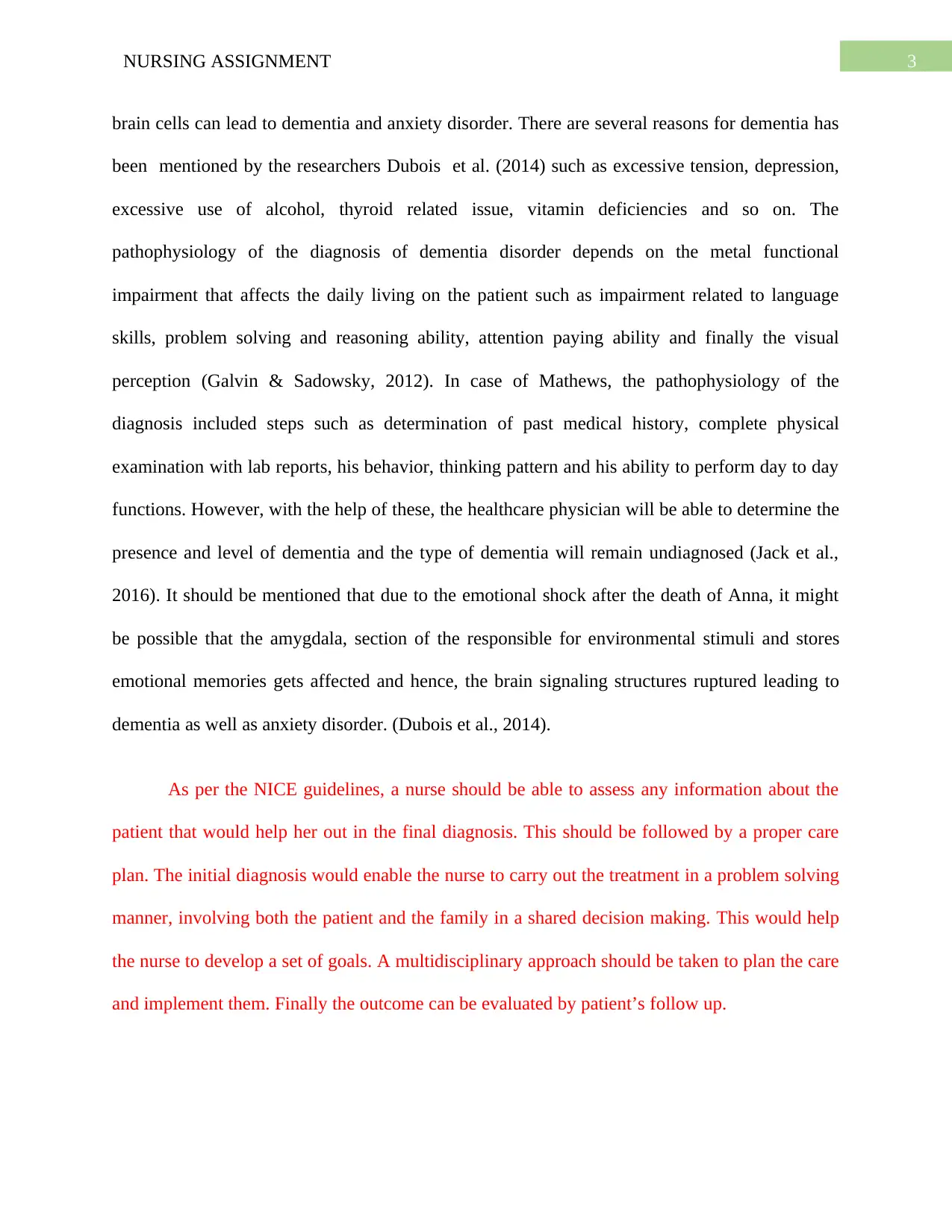
3NURSING ASSIGNMENT
brain cells can lead to dementia and anxiety disorder. There are several reasons for dementia has
been mentioned by the researchers Dubois et al. (2014) such as excessive tension, depression,
excessive use of alcohol, thyroid related issue, vitamin deficiencies and so on. The
pathophysiology of the diagnosis of dementia disorder depends on the metal functional
impairment that affects the daily living on the patient such as impairment related to language
skills, problem solving and reasoning ability, attention paying ability and finally the visual
perception (Galvin & Sadowsky, 2012). In case of Mathews, the pathophysiology of the
diagnosis included steps such as determination of past medical history, complete physical
examination with lab reports, his behavior, thinking pattern and his ability to perform day to day
functions. However, with the help of these, the healthcare physician will be able to determine the
presence and level of dementia and the type of dementia will remain undiagnosed (Jack et al.,
2016). It should be mentioned that due to the emotional shock after the death of Anna, it might
be possible that the amygdala, section of the responsible for environmental stimuli and stores
emotional memories gets affected and hence, the brain signaling structures ruptured leading to
dementia as well as anxiety disorder. (Dubois et al., 2014).
As per the NICE guidelines, a nurse should be able to assess any information about the
patient that would help her out in the final diagnosis. This should be followed by a proper care
plan. The initial diagnosis would enable the nurse to carry out the treatment in a problem solving
manner, involving both the patient and the family in a shared decision making. This would help
the nurse to develop a set of goals. A multidisciplinary approach should be taken to plan the care
and implement them. Finally the outcome can be evaluated by patient’s follow up.
brain cells can lead to dementia and anxiety disorder. There are several reasons for dementia has
been mentioned by the researchers Dubois et al. (2014) such as excessive tension, depression,
excessive use of alcohol, thyroid related issue, vitamin deficiencies and so on. The
pathophysiology of the diagnosis of dementia disorder depends on the metal functional
impairment that affects the daily living on the patient such as impairment related to language
skills, problem solving and reasoning ability, attention paying ability and finally the visual
perception (Galvin & Sadowsky, 2012). In case of Mathews, the pathophysiology of the
diagnosis included steps such as determination of past medical history, complete physical
examination with lab reports, his behavior, thinking pattern and his ability to perform day to day
functions. However, with the help of these, the healthcare physician will be able to determine the
presence and level of dementia and the type of dementia will remain undiagnosed (Jack et al.,
2016). It should be mentioned that due to the emotional shock after the death of Anna, it might
be possible that the amygdala, section of the responsible for environmental stimuli and stores
emotional memories gets affected and hence, the brain signaling structures ruptured leading to
dementia as well as anxiety disorder. (Dubois et al., 2014).
As per the NICE guidelines, a nurse should be able to assess any information about the
patient that would help her out in the final diagnosis. This should be followed by a proper care
plan. The initial diagnosis would enable the nurse to carry out the treatment in a problem solving
manner, involving both the patient and the family in a shared decision making. This would help
the nurse to develop a set of goals. A multidisciplinary approach should be taken to plan the care
and implement them. Finally the outcome can be evaluated by patient’s follow up.
Secure Best Marks with AI Grader
Need help grading? Try our AI Grader for instant feedback on your assignments.
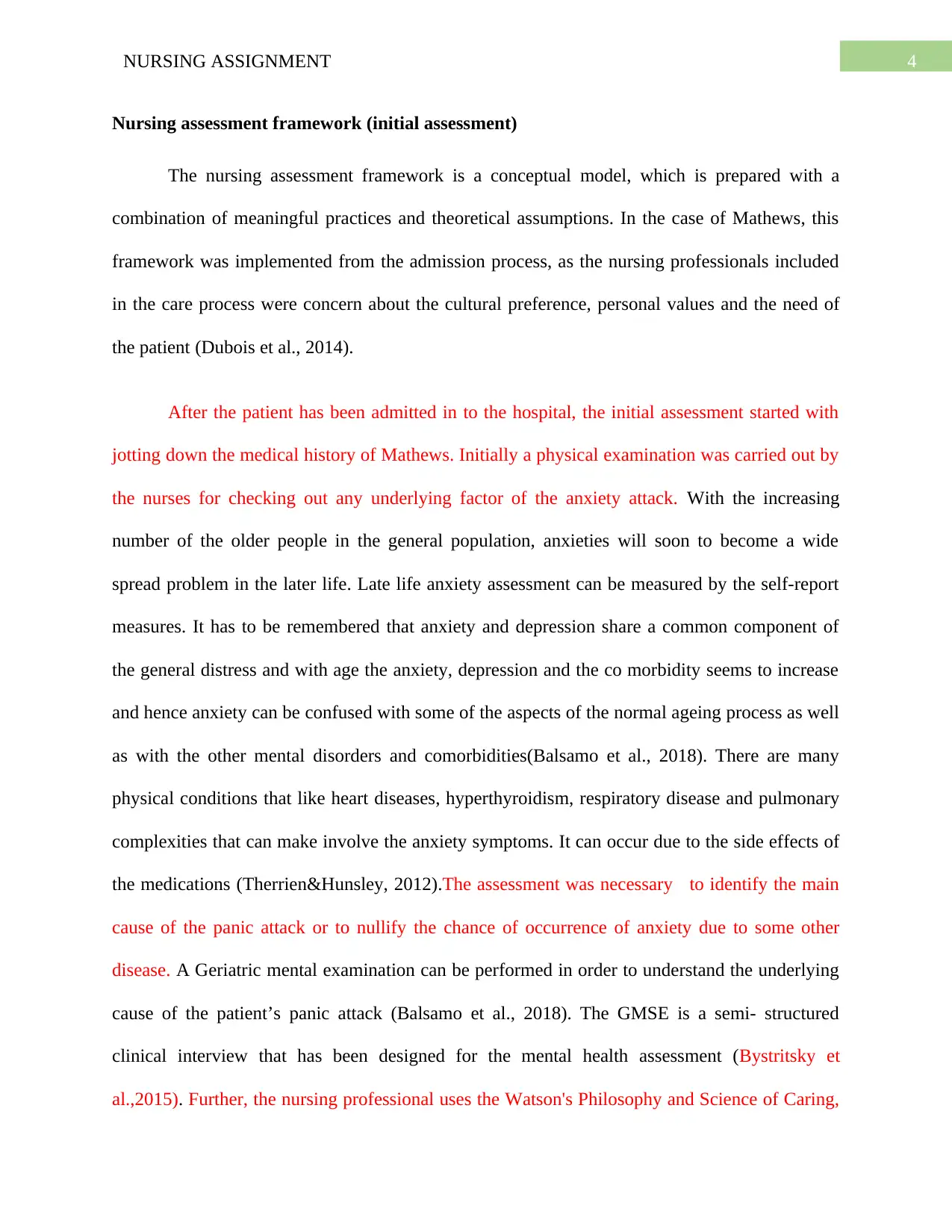
4NURSING ASSIGNMENT
Nursing assessment framework (initial assessment)
The nursing assessment framework is a conceptual model, which is prepared with a
combination of meaningful practices and theoretical assumptions. In the case of Mathews, this
framework was implemented from the admission process, as the nursing professionals included
in the care process were concern about the cultural preference, personal values and the need of
the patient (Dubois et al., 2014).
After the patient has been admitted in to the hospital, the initial assessment started with
jotting down the medical history of Mathews. Initially a physical examination was carried out by
the nurses for checking out any underlying factor of the anxiety attack. With the increasing
number of the older people in the general population, anxieties will soon to become a wide
spread problem in the later life. Late life anxiety assessment can be measured by the self-report
measures. It has to be remembered that anxiety and depression share a common component of
the general distress and with age the anxiety, depression and the co morbidity seems to increase
and hence anxiety can be confused with some of the aspects of the normal ageing process as well
as with the other mental disorders and comorbidities(Balsamo et al., 2018). There are many
physical conditions that like heart diseases, hyperthyroidism, respiratory disease and pulmonary
complexities that can make involve the anxiety symptoms. It can occur due to the side effects of
the medications (Therrien&Hunsley, 2012).The assessment was necessary to identify the main
cause of the panic attack or to nullify the chance of occurrence of anxiety due to some other
disease. A Geriatric mental examination can be performed in order to understand the underlying
cause of the patient’s panic attack (Balsamo et al., 2018). The GMSE is a semi- structured
clinical interview that has been designed for the mental health assessment (Bystritsky et
al.,2015). Further, the nursing professional uses the Watson's Philosophy and Science of Caring,
Nursing assessment framework (initial assessment)
The nursing assessment framework is a conceptual model, which is prepared with a
combination of meaningful practices and theoretical assumptions. In the case of Mathews, this
framework was implemented from the admission process, as the nursing professionals included
in the care process were concern about the cultural preference, personal values and the need of
the patient (Dubois et al., 2014).
After the patient has been admitted in to the hospital, the initial assessment started with
jotting down the medical history of Mathews. Initially a physical examination was carried out by
the nurses for checking out any underlying factor of the anxiety attack. With the increasing
number of the older people in the general population, anxieties will soon to become a wide
spread problem in the later life. Late life anxiety assessment can be measured by the self-report
measures. It has to be remembered that anxiety and depression share a common component of
the general distress and with age the anxiety, depression and the co morbidity seems to increase
and hence anxiety can be confused with some of the aspects of the normal ageing process as well
as with the other mental disorders and comorbidities(Balsamo et al., 2018). There are many
physical conditions that like heart diseases, hyperthyroidism, respiratory disease and pulmonary
complexities that can make involve the anxiety symptoms. It can occur due to the side effects of
the medications (Therrien&Hunsley, 2012).The assessment was necessary to identify the main
cause of the panic attack or to nullify the chance of occurrence of anxiety due to some other
disease. A Geriatric mental examination can be performed in order to understand the underlying
cause of the patient’s panic attack (Balsamo et al., 2018). The GMSE is a semi- structured
clinical interview that has been designed for the mental health assessment (Bystritsky et
al.,2015). Further, the nursing professional uses the Watson's Philosophy and Science of Caring,

5NURSING ASSIGNMENT
which has four primary aspects such as human, health, society and nursing interventions.
According to Watson, the core idea of nursing is protection, enhancement and preservation of
human dignity. Aligning with the theory it can be said that the patient was elderly, and the main
aim was to restore the functional status of the patient and to bring him back to the normal pace of
life. The healthcare professionals used this theory so that Mathews can connect to the
environmental around him and improve his dementia and depression related condition. Further, it
also helped to determine Mathew’s level of communication, his hygiene level, his mobility and
nurses helped him to promote his health improvement (Alligood, 2017). As this nursing theory
contains strong and accessible nursing intervention assessment for patient evaluation, the care
plan was properly scrutinized using this theory. All the information and the predisposing factors
were presented to the consultant, which was written in the final diagnosis.
The assessment period is followed by the diagnosis, which allows the health care
professionals to make determinations about the individuals and come to an opinion (Kitson et al.,
2014). A psychological evaluation was done to understand the symptoms, fears or conditions of
the patient, like how her daughter found her shaking and exhibiting delusional behavior, how he
had been found to be disturbed for the past few days.
Planning
Planning involves establishment of SMART goals for achieving a desired outcome. A
multidisciplinary team of four members were appointed for this case-, the nurse, the psychiatrist
and a nutritionist to chalk out the plan for the treatment of Mathews.
Short term goals
which has four primary aspects such as human, health, society and nursing interventions.
According to Watson, the core idea of nursing is protection, enhancement and preservation of
human dignity. Aligning with the theory it can be said that the patient was elderly, and the main
aim was to restore the functional status of the patient and to bring him back to the normal pace of
life. The healthcare professionals used this theory so that Mathews can connect to the
environmental around him and improve his dementia and depression related condition. Further, it
also helped to determine Mathew’s level of communication, his hygiene level, his mobility and
nurses helped him to promote his health improvement (Alligood, 2017). As this nursing theory
contains strong and accessible nursing intervention assessment for patient evaluation, the care
plan was properly scrutinized using this theory. All the information and the predisposing factors
were presented to the consultant, which was written in the final diagnosis.
The assessment period is followed by the diagnosis, which allows the health care
professionals to make determinations about the individuals and come to an opinion (Kitson et al.,
2014). A psychological evaluation was done to understand the symptoms, fears or conditions of
the patient, like how her daughter found her shaking and exhibiting delusional behavior, how he
had been found to be disturbed for the past few days.
Planning
Planning involves establishment of SMART goals for achieving a desired outcome. A
multidisciplinary team of four members were appointed for this case-, the nurse, the psychiatrist
and a nutritionist to chalk out the plan for the treatment of Mathews.
Short term goals
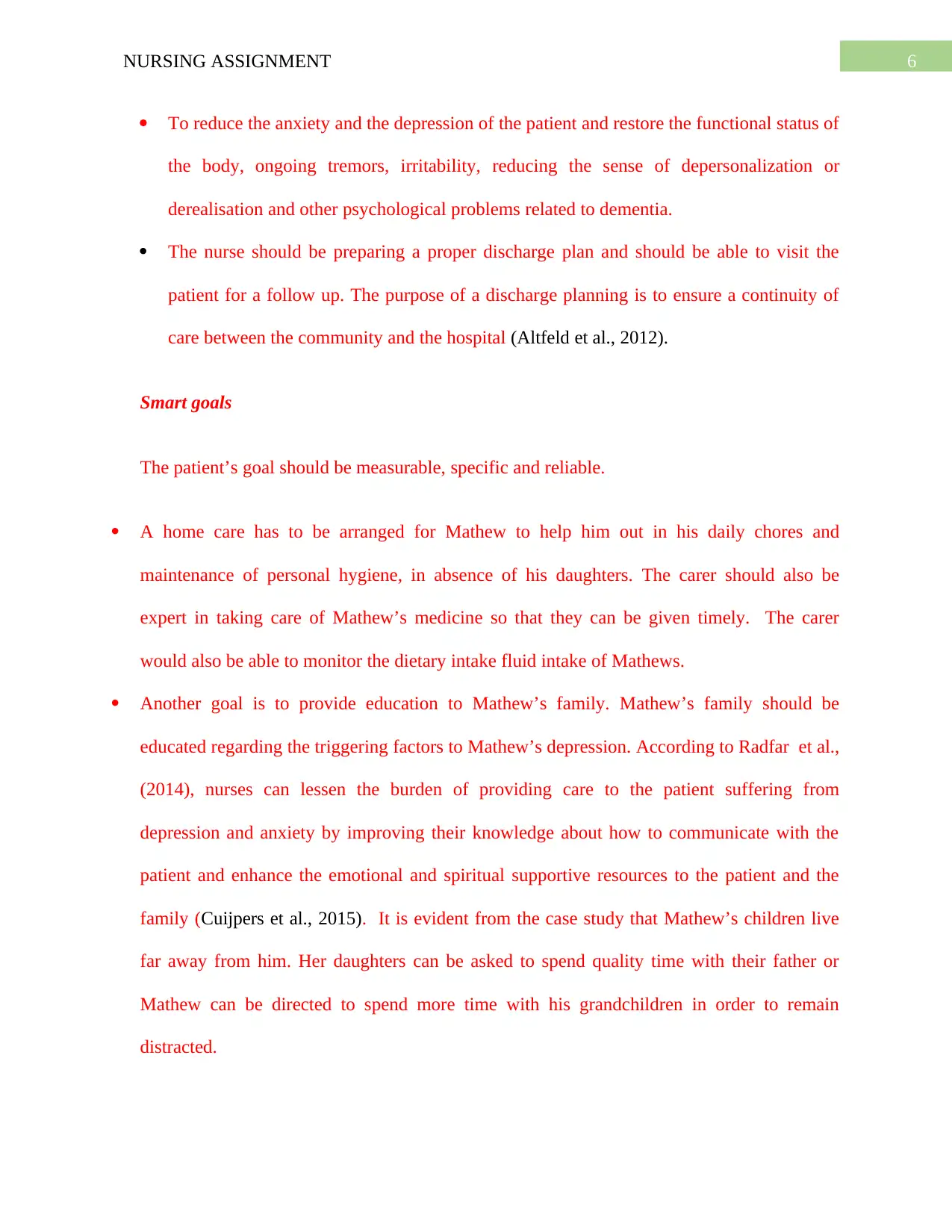
6NURSING ASSIGNMENT
To reduce the anxiety and the depression of the patient and restore the functional status of
the body, ongoing tremors, irritability, reducing the sense of depersonalization or
derealisation and other psychological problems related to dementia.
The nurse should be preparing a proper discharge plan and should be able to visit the
patient for a follow up. The purpose of a discharge planning is to ensure a continuity of
care between the community and the hospital (Altfeld et al., 2012).
Smart goals
The patient’s goal should be measurable, specific and reliable.
A home care has to be arranged for Mathew to help him out in his daily chores and
maintenance of personal hygiene, in absence of his daughters. The carer should also be
expert in taking care of Mathew’s medicine so that they can be given timely. The carer
would also be able to monitor the dietary intake fluid intake of Mathews.
Another goal is to provide education to Mathew’s family. Mathew’s family should be
educated regarding the triggering factors to Mathew’s depression. According to Radfar et al.,
(2014), nurses can lessen the burden of providing care to the patient suffering from
depression and anxiety by improving their knowledge about how to communicate with the
patient and enhance the emotional and spiritual supportive resources to the patient and the
family (Cuijpers et al., 2015). It is evident from the case study that Mathew’s children live
far away from him. Her daughters can be asked to spend quality time with their father or
Mathew can be directed to spend more time with his grandchildren in order to remain
distracted.
To reduce the anxiety and the depression of the patient and restore the functional status of
the body, ongoing tremors, irritability, reducing the sense of depersonalization or
derealisation and other psychological problems related to dementia.
The nurse should be preparing a proper discharge plan and should be able to visit the
patient for a follow up. The purpose of a discharge planning is to ensure a continuity of
care between the community and the hospital (Altfeld et al., 2012).
Smart goals
The patient’s goal should be measurable, specific and reliable.
A home care has to be arranged for Mathew to help him out in his daily chores and
maintenance of personal hygiene, in absence of his daughters. The carer should also be
expert in taking care of Mathew’s medicine so that they can be given timely. The carer
would also be able to monitor the dietary intake fluid intake of Mathews.
Another goal is to provide education to Mathew’s family. Mathew’s family should be
educated regarding the triggering factors to Mathew’s depression. According to Radfar et al.,
(2014), nurses can lessen the burden of providing care to the patient suffering from
depression and anxiety by improving their knowledge about how to communicate with the
patient and enhance the emotional and spiritual supportive resources to the patient and the
family (Cuijpers et al., 2015). It is evident from the case study that Mathew’s children live
far away from him. Her daughters can be asked to spend quality time with their father or
Mathew can be directed to spend more time with his grandchildren in order to remain
distracted.
Paraphrase This Document
Need a fresh take? Get an instant paraphrase of this document with our AI Paraphraser
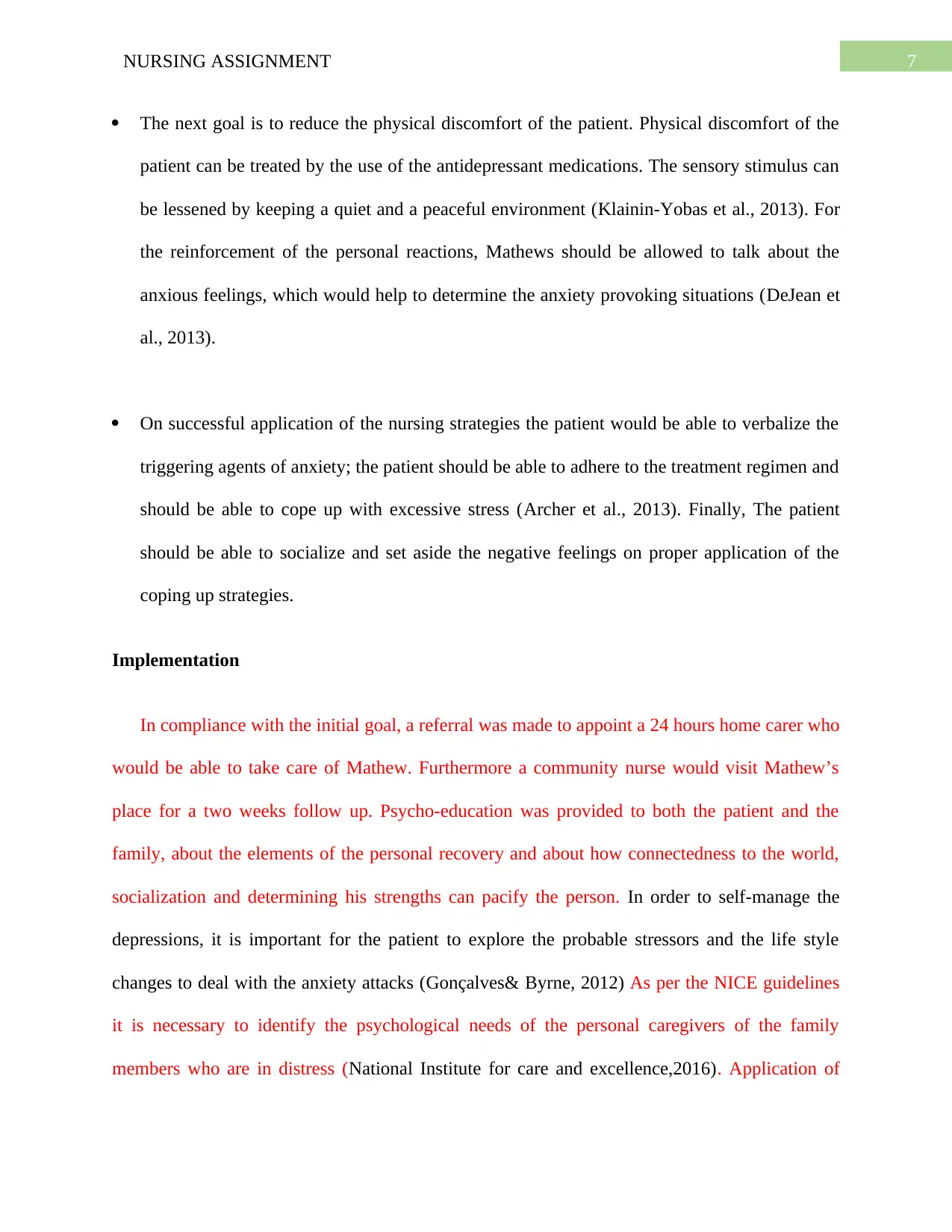
7NURSING ASSIGNMENT
The next goal is to reduce the physical discomfort of the patient. Physical discomfort of the
patient can be treated by the use of the antidepressant medications. The sensory stimulus can
be lessened by keeping a quiet and a peaceful environment (Klainin-Yobas et al., 2013). For
the reinforcement of the personal reactions, Mathews should be allowed to talk about the
anxious feelings, which would help to determine the anxiety provoking situations (DeJean et
al., 2013).
On successful application of the nursing strategies the patient would be able to verbalize the
triggering agents of anxiety; the patient should be able to adhere to the treatment regimen and
should be able to cope up with excessive stress (Archer et al., 2013). Finally, The patient
should be able to socialize and set aside the negative feelings on proper application of the
coping up strategies.
Implementation
In compliance with the initial goal, a referral was made to appoint a 24 hours home carer who
would be able to take care of Mathew. Furthermore a community nurse would visit Mathew’s
place for a two weeks follow up. Psycho-education was provided to both the patient and the
family, about the elements of the personal recovery and about how connectedness to the world,
socialization and determining his strengths can pacify the person. In order to self-manage the
depressions, it is important for the patient to explore the probable stressors and the life style
changes to deal with the anxiety attacks (Gonçalves& Byrne, 2012) As per the NICE guidelines
it is necessary to identify the psychological needs of the personal caregivers of the family
members who are in distress (National Institute for care and excellence,2016). Application of
The next goal is to reduce the physical discomfort of the patient. Physical discomfort of the
patient can be treated by the use of the antidepressant medications. The sensory stimulus can
be lessened by keeping a quiet and a peaceful environment (Klainin-Yobas et al., 2013). For
the reinforcement of the personal reactions, Mathews should be allowed to talk about the
anxious feelings, which would help to determine the anxiety provoking situations (DeJean et
al., 2013).
On successful application of the nursing strategies the patient would be able to verbalize the
triggering agents of anxiety; the patient should be able to adhere to the treatment regimen and
should be able to cope up with excessive stress (Archer et al., 2013). Finally, The patient
should be able to socialize and set aside the negative feelings on proper application of the
coping up strategies.
Implementation
In compliance with the initial goal, a referral was made to appoint a 24 hours home carer who
would be able to take care of Mathew. Furthermore a community nurse would visit Mathew’s
place for a two weeks follow up. Psycho-education was provided to both the patient and the
family, about the elements of the personal recovery and about how connectedness to the world,
socialization and determining his strengths can pacify the person. In order to self-manage the
depressions, it is important for the patient to explore the probable stressors and the life style
changes to deal with the anxiety attacks (Gonçalves& Byrne, 2012) As per the NICE guidelines
it is necessary to identify the psychological needs of the personal caregivers of the family
members who are in distress (National Institute for care and excellence,2016). Application of
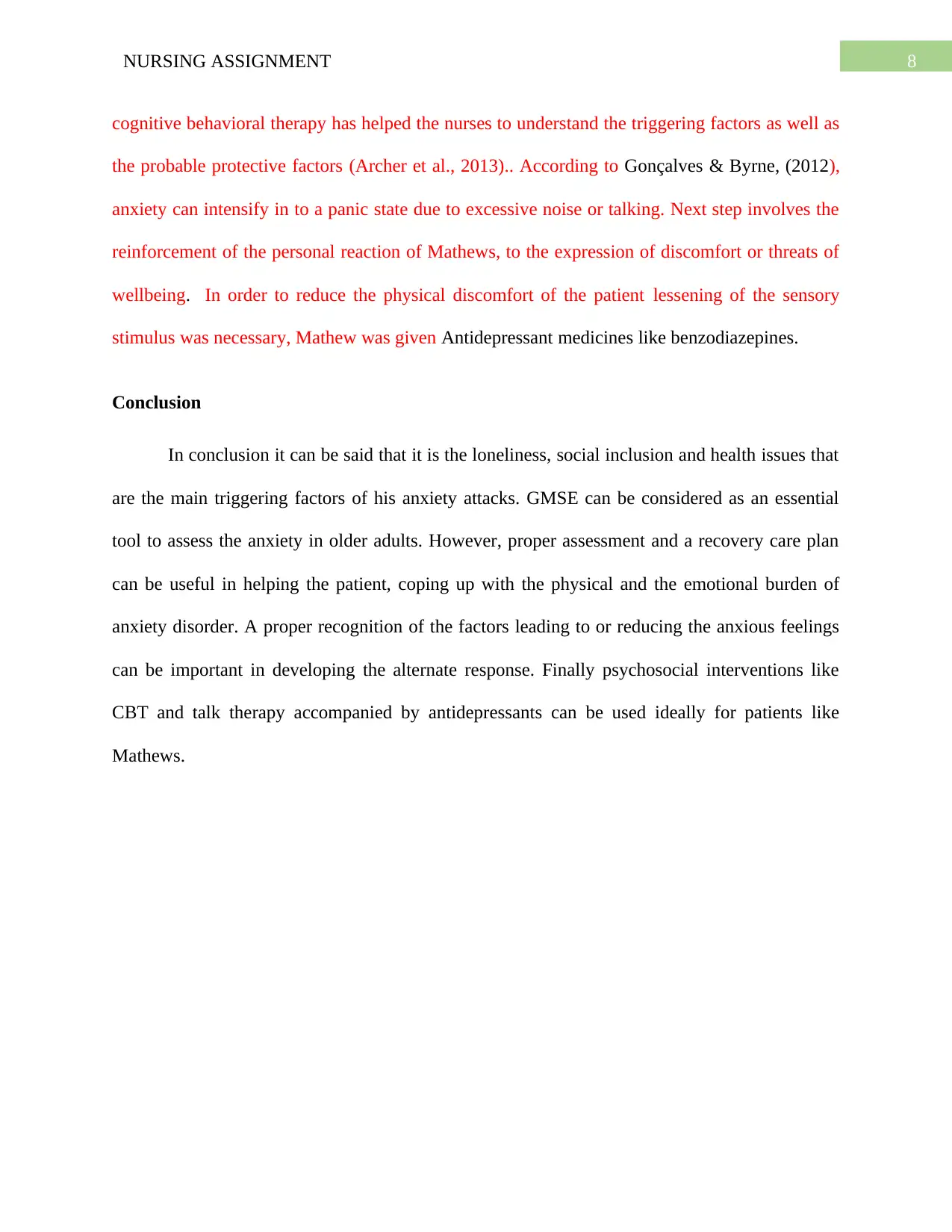
8NURSING ASSIGNMENT
cognitive behavioral therapy has helped the nurses to understand the triggering factors as well as
the probable protective factors (Archer et al., 2013).. According to Gonçalves & Byrne, (2012),
anxiety can intensify in to a panic state due to excessive noise or talking. Next step involves the
reinforcement of the personal reaction of Mathews, to the expression of discomfort or threats of
wellbeing. In order to reduce the physical discomfort of the patient lessening of the sensory
stimulus was necessary, Mathew was given Antidepressant medicines like benzodiazepines.
Conclusion
In conclusion it can be said that it is the loneliness, social inclusion and health issues that
are the main triggering factors of his anxiety attacks. GMSE can be considered as an essential
tool to assess the anxiety in older adults. However, proper assessment and a recovery care plan
can be useful in helping the patient, coping up with the physical and the emotional burden of
anxiety disorder. A proper recognition of the factors leading to or reducing the anxious feelings
can be important in developing the alternate response. Finally psychosocial interventions like
CBT and talk therapy accompanied by antidepressants can be used ideally for patients like
Mathews.
cognitive behavioral therapy has helped the nurses to understand the triggering factors as well as
the probable protective factors (Archer et al., 2013).. According to Gonçalves & Byrne, (2012),
anxiety can intensify in to a panic state due to excessive noise or talking. Next step involves the
reinforcement of the personal reaction of Mathews, to the expression of discomfort or threats of
wellbeing. In order to reduce the physical discomfort of the patient lessening of the sensory
stimulus was necessary, Mathew was given Antidepressant medicines like benzodiazepines.
Conclusion
In conclusion it can be said that it is the loneliness, social inclusion and health issues that
are the main triggering factors of his anxiety attacks. GMSE can be considered as an essential
tool to assess the anxiety in older adults. However, proper assessment and a recovery care plan
can be useful in helping the patient, coping up with the physical and the emotional burden of
anxiety disorder. A proper recognition of the factors leading to or reducing the anxious feelings
can be important in developing the alternate response. Finally psychosocial interventions like
CBT and talk therapy accompanied by antidepressants can be used ideally for patients like
Mathews.
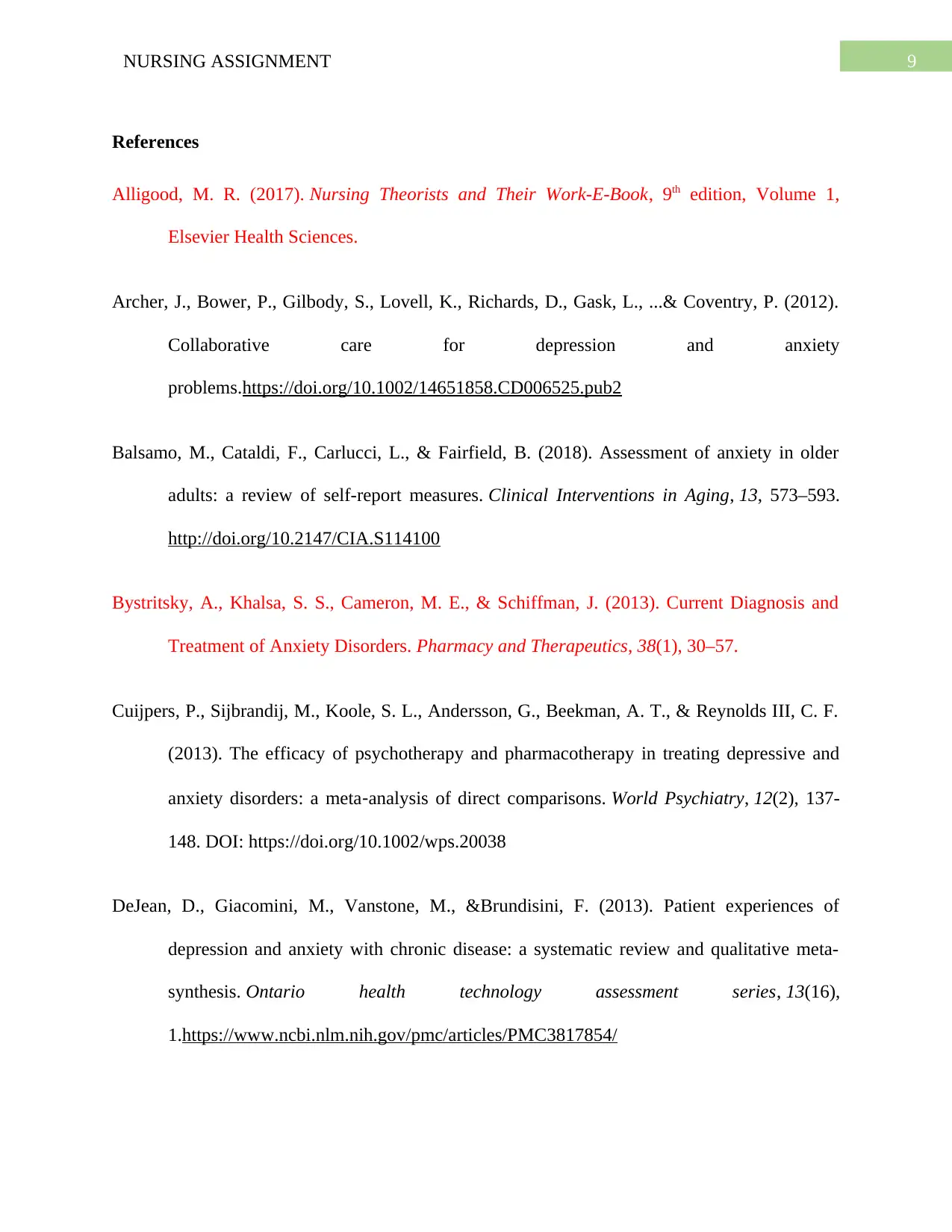
9NURSING ASSIGNMENT
References
Alligood, M. R. (2017). Nursing Theorists and Their Work-E-Book, 9th edition, Volume 1,
Elsevier Health Sciences.
Archer, J., Bower, P., Gilbody, S., Lovell, K., Richards, D., Gask, L., ...& Coventry, P. (2012).
Collaborative care for depression and anxiety
problems.https://doi.org/10.1002/14651858.CD006525.pub2
Balsamo, M., Cataldi, F., Carlucci, L., & Fairfield, B. (2018). Assessment of anxiety in older
adults: a review of self-report measures. Clinical Interventions in Aging, 13, 573–593.
http://doi.org/10.2147/CIA.S114100
Bystritsky, A., Khalsa, S. S., Cameron, M. E., & Schiffman, J. (2013). Current Diagnosis and
Treatment of Anxiety Disorders. Pharmacy and Therapeutics, 38(1), 30–57.
Cuijpers, P., Sijbrandij, M., Koole, S. L., Andersson, G., Beekman, A. T., & Reynolds III, C. F.
(2013). The efficacy of psychotherapy and pharmacotherapy in treating depressive and
anxiety disorders: a meta‐analysis of direct comparisons. World Psychiatry, 12(2), 137-
148. DOI: https://doi.org/10.1002/wps.20038
DeJean, D., Giacomini, M., Vanstone, M., &Brundisini, F. (2013). Patient experiences of
depression and anxiety with chronic disease: a systematic review and qualitative meta-
synthesis. Ontario health technology assessment series, 13(16),
1.https://www.ncbi.nlm.nih.gov/pmc/articles/PMC3817854/
References
Alligood, M. R. (2017). Nursing Theorists and Their Work-E-Book, 9th edition, Volume 1,
Elsevier Health Sciences.
Archer, J., Bower, P., Gilbody, S., Lovell, K., Richards, D., Gask, L., ...& Coventry, P. (2012).
Collaborative care for depression and anxiety
problems.https://doi.org/10.1002/14651858.CD006525.pub2
Balsamo, M., Cataldi, F., Carlucci, L., & Fairfield, B. (2018). Assessment of anxiety in older
adults: a review of self-report measures. Clinical Interventions in Aging, 13, 573–593.
http://doi.org/10.2147/CIA.S114100
Bystritsky, A., Khalsa, S. S., Cameron, M. E., & Schiffman, J. (2013). Current Diagnosis and
Treatment of Anxiety Disorders. Pharmacy and Therapeutics, 38(1), 30–57.
Cuijpers, P., Sijbrandij, M., Koole, S. L., Andersson, G., Beekman, A. T., & Reynolds III, C. F.
(2013). The efficacy of psychotherapy and pharmacotherapy in treating depressive and
anxiety disorders: a meta‐analysis of direct comparisons. World Psychiatry, 12(2), 137-
148. DOI: https://doi.org/10.1002/wps.20038
DeJean, D., Giacomini, M., Vanstone, M., &Brundisini, F. (2013). Patient experiences of
depression and anxiety with chronic disease: a systematic review and qualitative meta-
synthesis. Ontario health technology assessment series, 13(16),
1.https://www.ncbi.nlm.nih.gov/pmc/articles/PMC3817854/
Secure Best Marks with AI Grader
Need help grading? Try our AI Grader for instant feedback on your assignments.
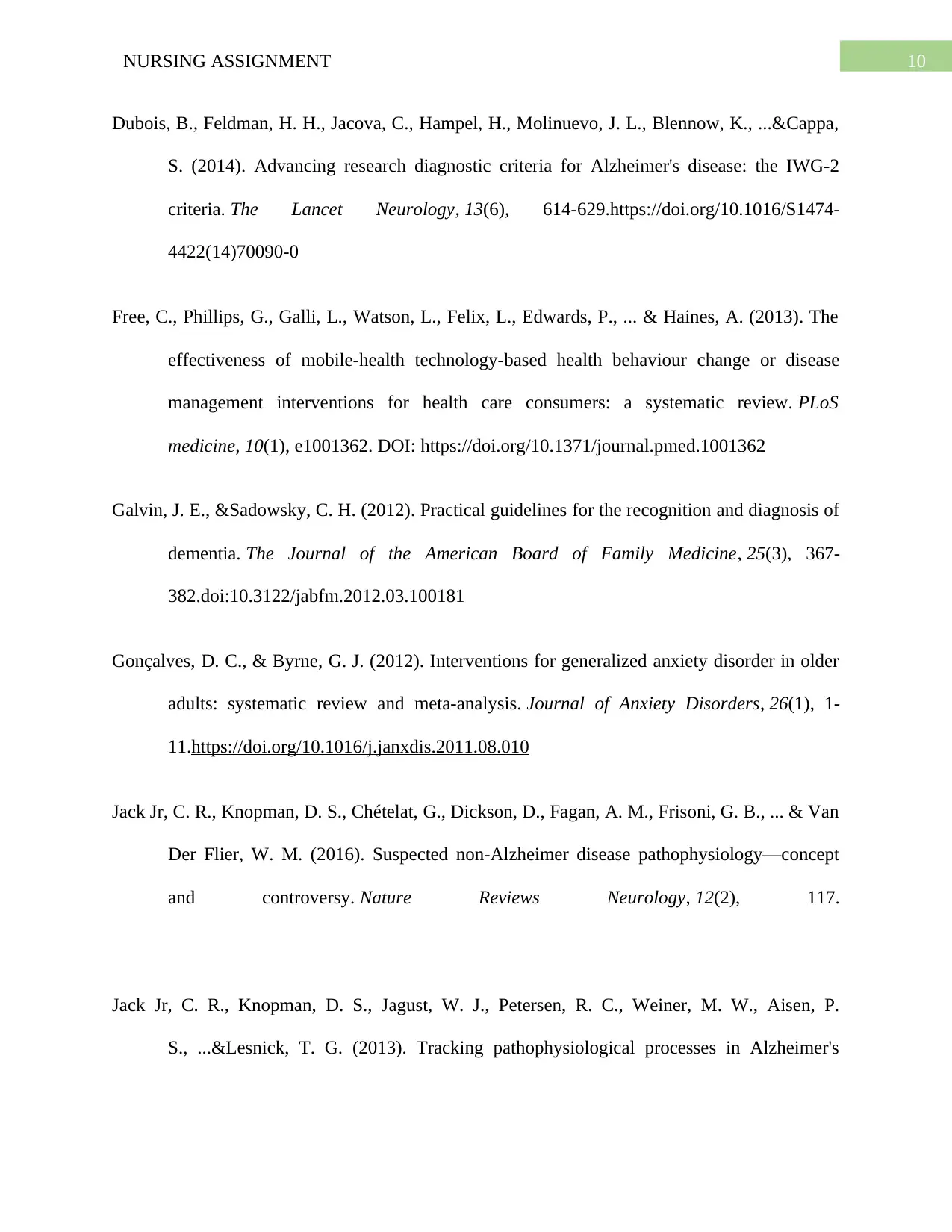
10NURSING ASSIGNMENT
Dubois, B., Feldman, H. H., Jacova, C., Hampel, H., Molinuevo, J. L., Blennow, K., ...&Cappa,
S. (2014). Advancing research diagnostic criteria for Alzheimer's disease: the IWG-2
criteria. The Lancet Neurology, 13(6), 614-629.https://doi.org/10.1016/S1474-
4422(14)70090-0
Free, C., Phillips, G., Galli, L., Watson, L., Felix, L., Edwards, P., ... & Haines, A. (2013). The
effectiveness of mobile-health technology-based health behaviour change or disease
management interventions for health care consumers: a systematic review. PLoS
medicine, 10(1), e1001362. DOI: https://doi.org/10.1371/journal.pmed.1001362
Galvin, J. E., &Sadowsky, C. H. (2012). Practical guidelines for the recognition and diagnosis of
dementia. The Journal of the American Board of Family Medicine, 25(3), 367-
382.doi:10.3122/jabfm.2012.03.100181
Gonçalves, D. C., & Byrne, G. J. (2012). Interventions for generalized anxiety disorder in older
adults: systematic review and meta-analysis. Journal of Anxiety Disorders, 26(1), 1-
11.https://doi.org/10.1016/j.janxdis.2011.08.010
Jack Jr, C. R., Knopman, D. S., Chételat, G., Dickson, D., Fagan, A. M., Frisoni, G. B., ... & Van
Der Flier, W. M. (2016). Suspected non-Alzheimer disease pathophysiology—concept
and controversy. Nature Reviews Neurology, 12(2), 117.
Jack Jr, C. R., Knopman, D. S., Jagust, W. J., Petersen, R. C., Weiner, M. W., Aisen, P.
S., ...&Lesnick, T. G. (2013). Tracking pathophysiological processes in Alzheimer's
Dubois, B., Feldman, H. H., Jacova, C., Hampel, H., Molinuevo, J. L., Blennow, K., ...&Cappa,
S. (2014). Advancing research diagnostic criteria for Alzheimer's disease: the IWG-2
criteria. The Lancet Neurology, 13(6), 614-629.https://doi.org/10.1016/S1474-
4422(14)70090-0
Free, C., Phillips, G., Galli, L., Watson, L., Felix, L., Edwards, P., ... & Haines, A. (2013). The
effectiveness of mobile-health technology-based health behaviour change or disease
management interventions for health care consumers: a systematic review. PLoS
medicine, 10(1), e1001362. DOI: https://doi.org/10.1371/journal.pmed.1001362
Galvin, J. E., &Sadowsky, C. H. (2012). Practical guidelines for the recognition and diagnosis of
dementia. The Journal of the American Board of Family Medicine, 25(3), 367-
382.doi:10.3122/jabfm.2012.03.100181
Gonçalves, D. C., & Byrne, G. J. (2012). Interventions for generalized anxiety disorder in older
adults: systematic review and meta-analysis. Journal of Anxiety Disorders, 26(1), 1-
11.https://doi.org/10.1016/j.janxdis.2011.08.010
Jack Jr, C. R., Knopman, D. S., Chételat, G., Dickson, D., Fagan, A. M., Frisoni, G. B., ... & Van
Der Flier, W. M. (2016). Suspected non-Alzheimer disease pathophysiology—concept
and controversy. Nature Reviews Neurology, 12(2), 117.
Jack Jr, C. R., Knopman, D. S., Jagust, W. J., Petersen, R. C., Weiner, M. W., Aisen, P.
S., ...&Lesnick, T. G. (2013). Tracking pathophysiological processes in Alzheimer's
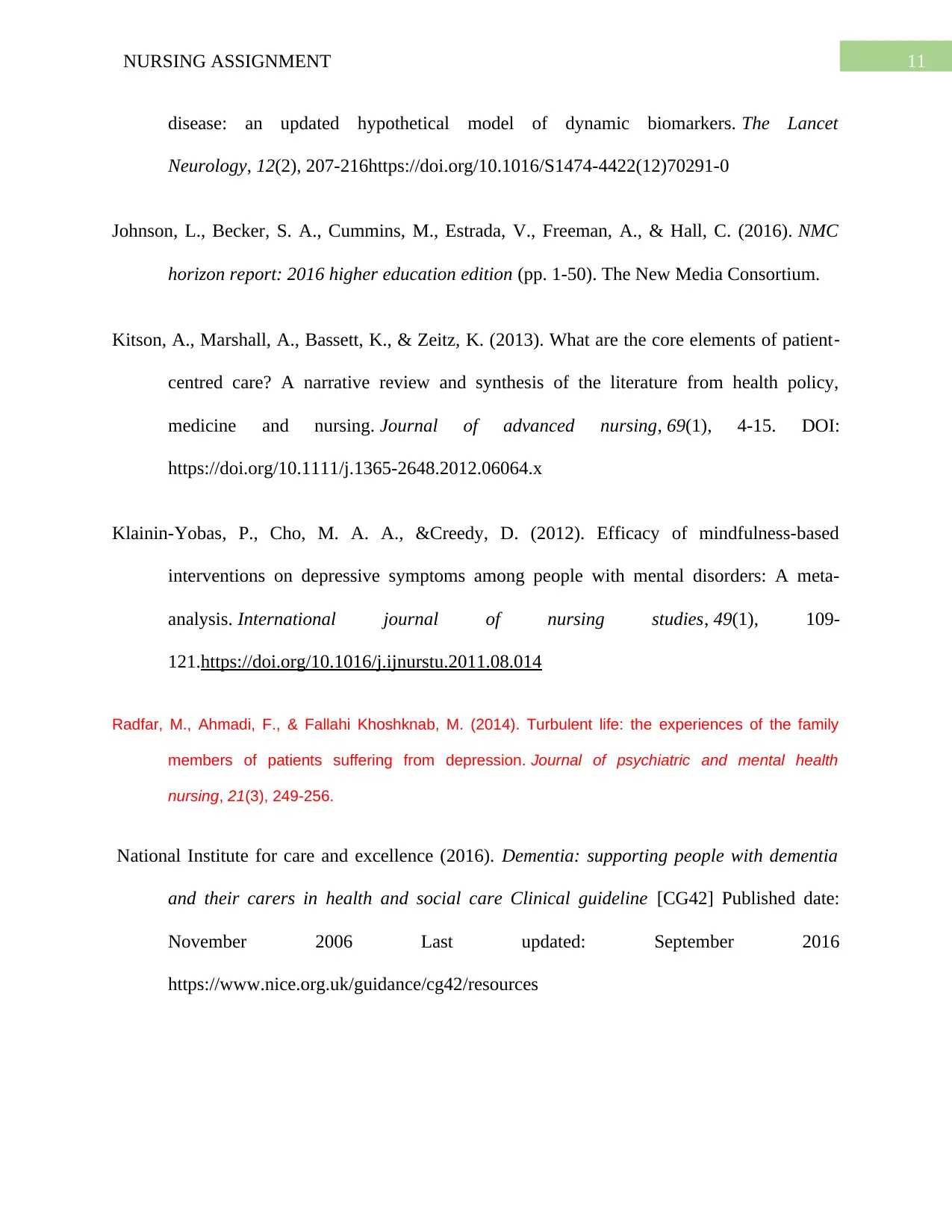
11NURSING ASSIGNMENT
disease: an updated hypothetical model of dynamic biomarkers. The Lancet
Neurology, 12(2), 207-216https://doi.org/10.1016/S1474-4422(12)70291-0
Johnson, L., Becker, S. A., Cummins, M., Estrada, V., Freeman, A., & Hall, C. (2016). NMC
horizon report: 2016 higher education edition (pp. 1-50). The New Media Consortium.
Kitson, A., Marshall, A., Bassett, K., & Zeitz, K. (2013). What are the core elements of patient‐
centred care? A narrative review and synthesis of the literature from health policy,
medicine and nursing. Journal of advanced nursing, 69(1), 4-15. DOI:
https://doi.org/10.1111/j.1365-2648.2012.06064.x
Klainin-Yobas, P., Cho, M. A. A., &Creedy, D. (2012). Efficacy of mindfulness-based
interventions on depressive symptoms among people with mental disorders: A meta-
analysis. International journal of nursing studies, 49(1), 109-
121.https://doi.org/10.1016/j.ijnurstu.2011.08.014
Radfar, M., Ahmadi, F., & Fallahi Khoshknab, M. (2014). Turbulent life: the experiences of the family
members of patients suffering from depression. Journal of psychiatric and mental health
nursing, 21(3), 249-256.
National Institute for care and excellence (2016). Dementia: supporting people with dementia
and their carers in health and social care Clinical guideline [CG42] Published date:
November 2006 Last updated: September 2016
https://www.nice.org.uk/guidance/cg42/resources
disease: an updated hypothetical model of dynamic biomarkers. The Lancet
Neurology, 12(2), 207-216https://doi.org/10.1016/S1474-4422(12)70291-0
Johnson, L., Becker, S. A., Cummins, M., Estrada, V., Freeman, A., & Hall, C. (2016). NMC
horizon report: 2016 higher education edition (pp. 1-50). The New Media Consortium.
Kitson, A., Marshall, A., Bassett, K., & Zeitz, K. (2013). What are the core elements of patient‐
centred care? A narrative review and synthesis of the literature from health policy,
medicine and nursing. Journal of advanced nursing, 69(1), 4-15. DOI:
https://doi.org/10.1111/j.1365-2648.2012.06064.x
Klainin-Yobas, P., Cho, M. A. A., &Creedy, D. (2012). Efficacy of mindfulness-based
interventions on depressive symptoms among people with mental disorders: A meta-
analysis. International journal of nursing studies, 49(1), 109-
121.https://doi.org/10.1016/j.ijnurstu.2011.08.014
Radfar, M., Ahmadi, F., & Fallahi Khoshknab, M. (2014). Turbulent life: the experiences of the family
members of patients suffering from depression. Journal of psychiatric and mental health
nursing, 21(3), 249-256.
National Institute for care and excellence (2016). Dementia: supporting people with dementia
and their carers in health and social care Clinical guideline [CG42] Published date:
November 2006 Last updated: September 2016
https://www.nice.org.uk/guidance/cg42/resources
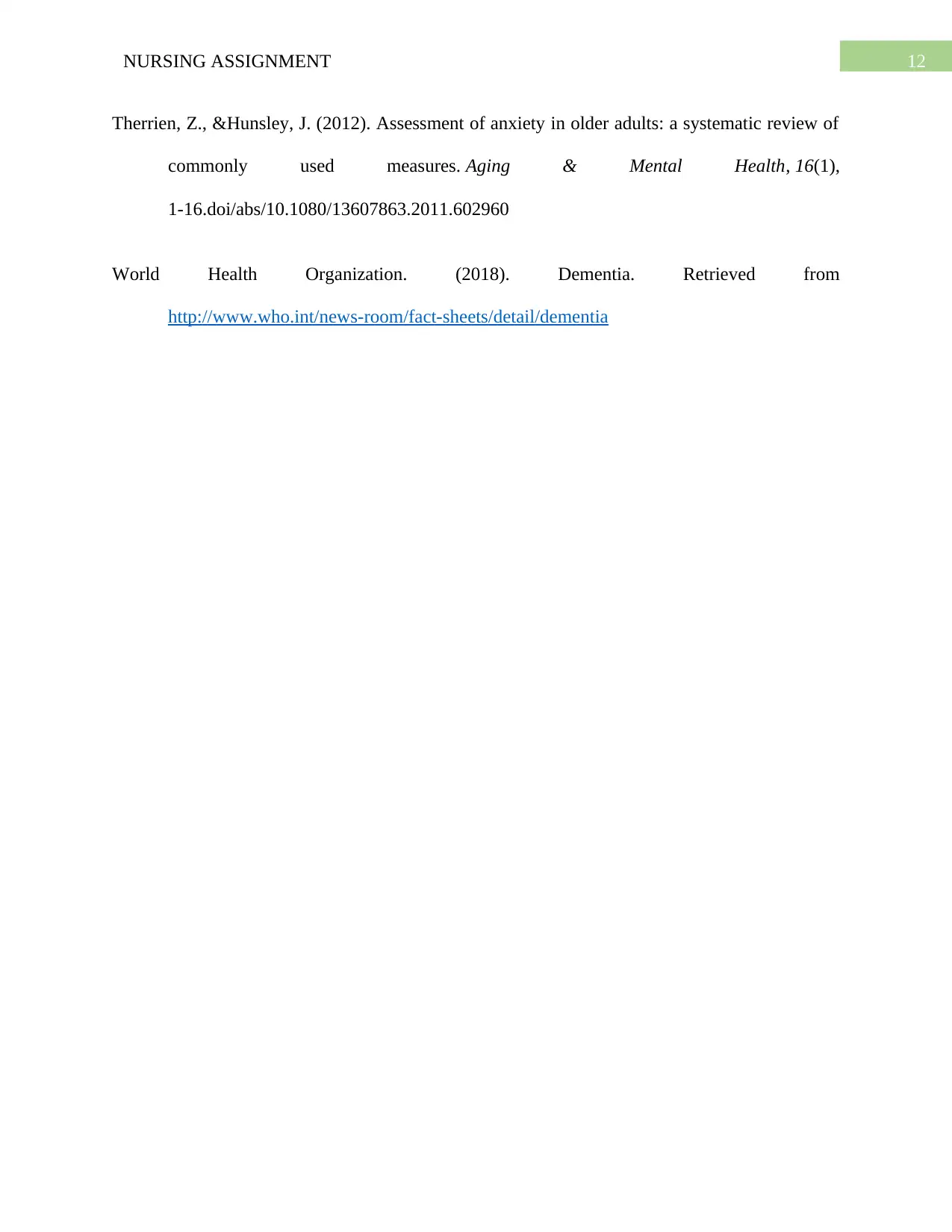
12NURSING ASSIGNMENT
Therrien, Z., &Hunsley, J. (2012). Assessment of anxiety in older adults: a systematic review of
commonly used measures. Aging & Mental Health, 16(1),
1-16.doi/abs/10.1080/13607863.2011.602960
World Health Organization. (2018). Dementia. Retrieved from
http://www.who.int/news-room/fact-sheets/detail/dementia
Therrien, Z., &Hunsley, J. (2012). Assessment of anxiety in older adults: a systematic review of
commonly used measures. Aging & Mental Health, 16(1),
1-16.doi/abs/10.1080/13607863.2011.602960
World Health Organization. (2018). Dementia. Retrieved from
http://www.who.int/news-room/fact-sheets/detail/dementia
1 out of 13
Related Documents
Your All-in-One AI-Powered Toolkit for Academic Success.
+13062052269
info@desklib.com
Available 24*7 on WhatsApp / Email
![[object Object]](/_next/static/media/star-bottom.7253800d.svg)
Unlock your academic potential
© 2024 | Zucol Services PVT LTD | All rights reserved.





